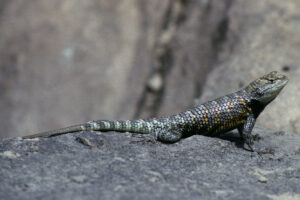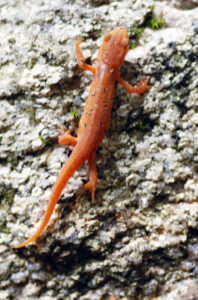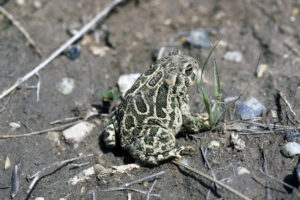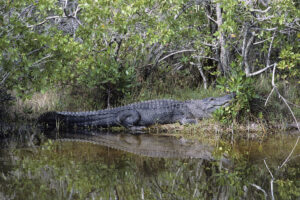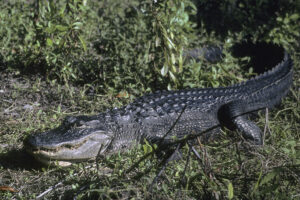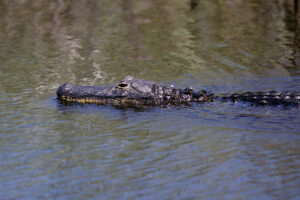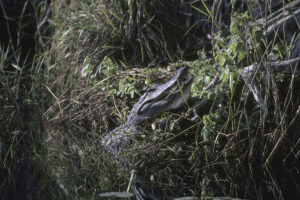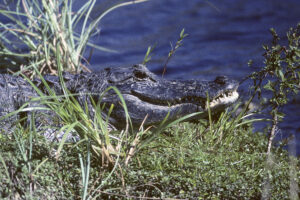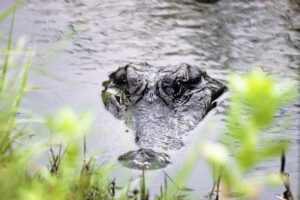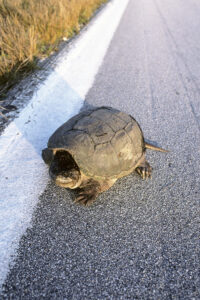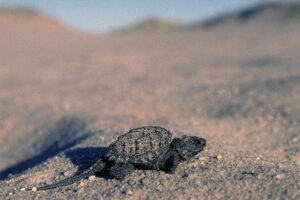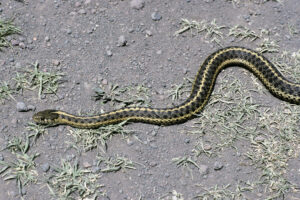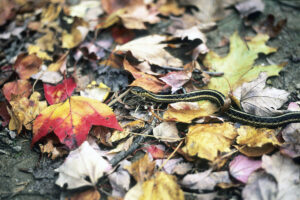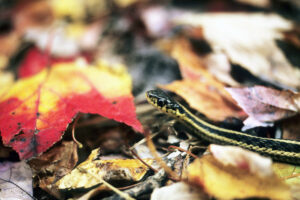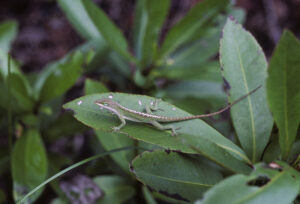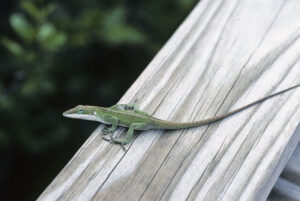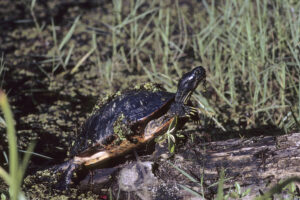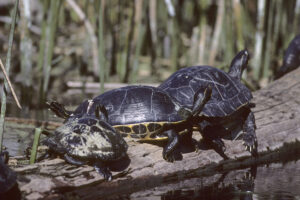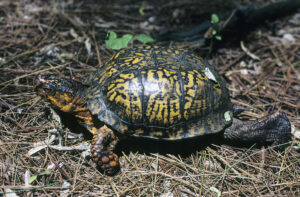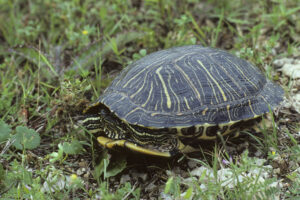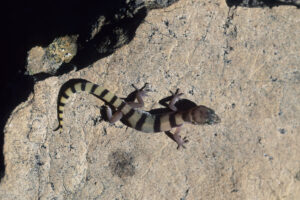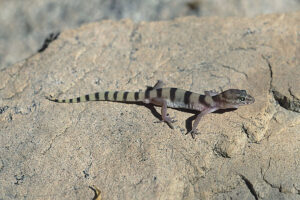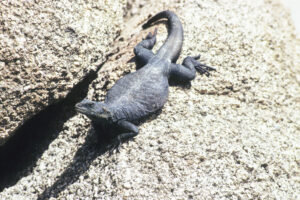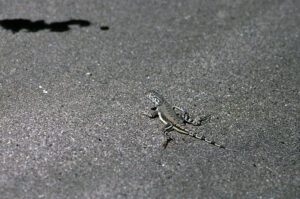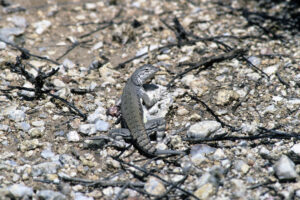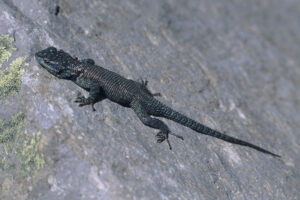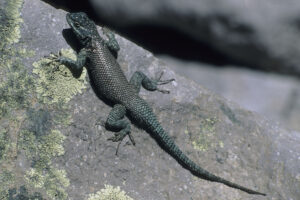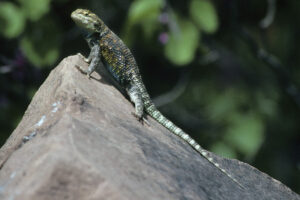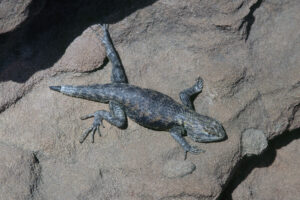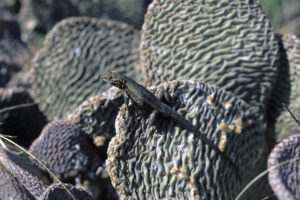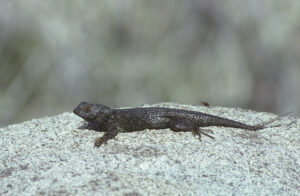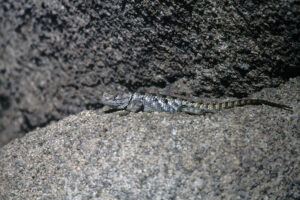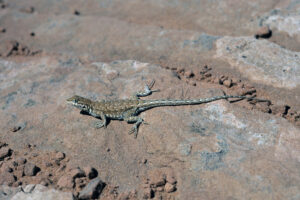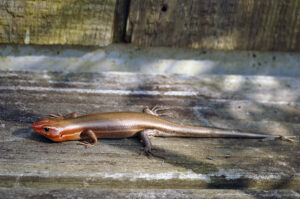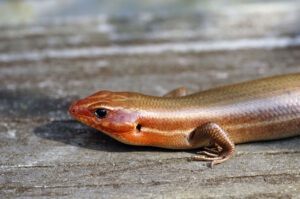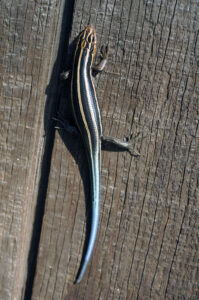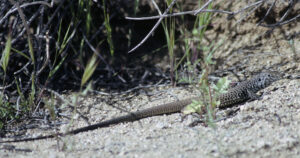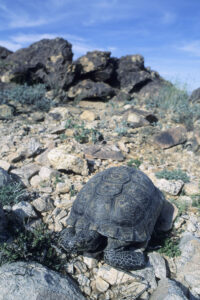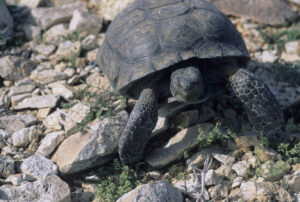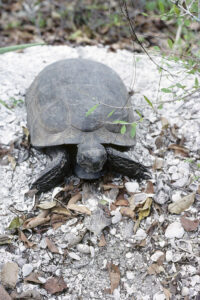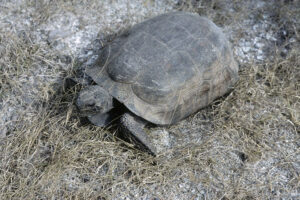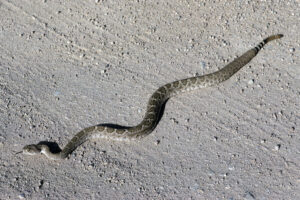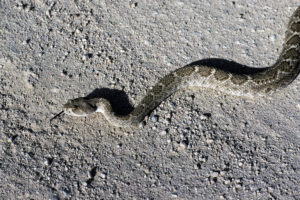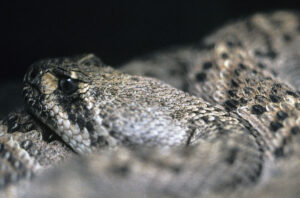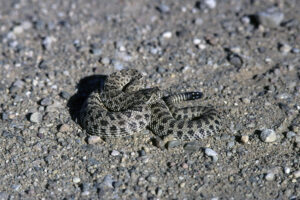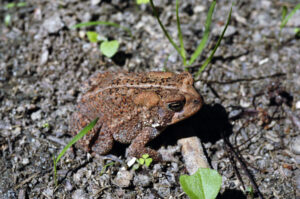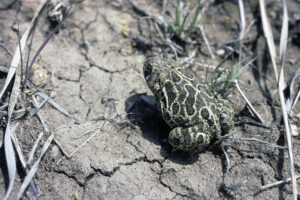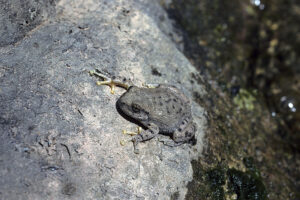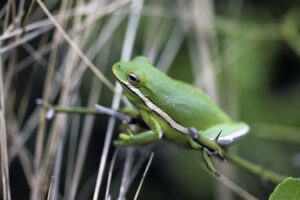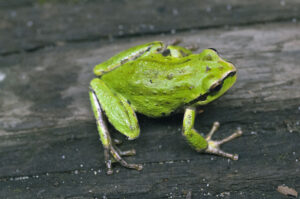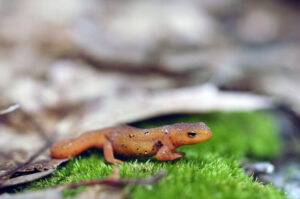Reptiles and amphibians in the United States
American alligator (Alligator mississippiensis) at dawn, Big Cypress National Preserve, Florida. (Photo copyright © by Kaj Halberg)
Male desert spiny lizard (Sceloporus magister), Grand Canyon, Arizona. (Photo copyright © by Kaj Halberg)
The nominate race of the eastern newt (Notophthalmus viridescens), called red-spotted newt, is found from south-eastern Canada southwards to Alabama and Georgia. This juvenile was encountered in Pawtuckaway State Park, New Hampshire. (Photo copyright © by Kaj Halberg)
Western terrestrial garter snake (Thamnophis elegans), Malheur National Wildlife Refuge, Oregon. (Photo copyright © by Kaj Halberg)
Great plains toad (Anaxyrus cognatus), Badlands National Park, South Dakota. (Photo copyright © by Kaj Halberg)
This page deals with a selection of reptiles and amphibians, which I have encountered during numerous visits to the United States since 1992. Within each of the two groups, families, genera, and species are presented in alphabetical order. When writing the text, the websites Wikipedia, reptile-database.reptarium.cz, and amphibiaweb.org have been of great value.
In case you find any errors on this page, I would be grateful to receive an email. You may use the address at the bottom of the page.
Reptiles
Alligatoridae Alligators and caimans
This family contains 8 species of crocodile-like animals, 2 alligators in a single genus and 6 caimans in 3 genera. Alligators live in the United States and China, whereas caimans are restricted to Central America and northern South America.
Alligator Alligators
Only 2 species of this formerly larger genus exist today, the American alligator (below) and the Chinese alligator (A. sinensis).
The generic name most likely stems from el lagarto (‘the lizard’), a term, which early Spanish explorers and settlers in Florida used for the alligator. This word derives from the Latin lacertus (‘lizard’).
Alligator mississippiensis American alligator
This large animal, males growing to 4.6 m long and weighing up to 450 kg, lives in swamps in south-eastern United States, from Florida, Mississippi, Louisiana, and eastern Texas northwards to Tennessee and North Carolina.
In the 1800s and the first half of the 1900s, hunting and habitat depleted its numbers seriously, and it was feared that it would not survive. In 1967, it was listed as an endangered species and was legally protected. Since then, conservation efforts have been successful, and today it is again common, and has even expanded its range to Tennessee.
This American alligator in J. N. Darling National Wildlife Refuge, Florida, is about 3 m long. (Photos copyright © by Kaj Halberg)
Alligator, Everglades National Park, Florida. (Photos copyright © by Kaj Halberg)
Portrait of an alligator, Aransas National Wildlife Refuge, Texas. (Photo copyright © by Kaj Halberg)
Chelydridae Snapping turtle family
A small family with 2 genera, Chelydra (below), and Macrochelys (alligator snapping turtles) with 1-3 species. Members live in North America, Central America, and north-western South America.
Chelydra Snapping turtles
This small genus contains 3 species, 1 in North America, and 2 in Central America and north-western South America.
The generic name is derived from Ancient Greek chelydros, a venomous water snake, or a kind of turtle, originally from chelys (‘tortoise’) and hydros, the grass snake (Natrix natrix). In this connection, due to the rather frightening appearance of these snapping animals, the word probably refers to Hydra, a many-headed serpentine sea monster in Greek mythology, whose breath was poisonous and its blood so virulent that even its scent was deadly.
The common name refers to the habit of these animals snapping at people when cornered. They can inflict quite a serious wound.
Chelydra serpentina Common snapping turtle
A large turtle, in which adults may reach lengths of 25-50 cm and a weight of 4.5-16 kg. It is widespread, found from south-central and south-eastern Canada southwards to Texas and Florida, westwards to the Rocky Mountains.
Presumably, the specific name has the same meaning as the generic name.
Common snapping turtle, crossing a road, Big Cypress National Preserve, Florida. (Photos copyright © by Kaj Halberg)
Illuminated by the late afternoon sun, this young snapping turtle is crawling up a sand dune in Napeague State Park, Long Island. (Photo copyright © by Kaj Halberg)
Colubridae Grass snakes, keelbacks, and allies
This is the largest family of snakes, comprising over 250 genera and more than 2,100 species. They are found on all continents, except Antarctica. Members of the family are non-toxic, with a few exceptions.
Thamnophis Garter snakes
A widespread genus with about 35 species, ranging from southern Canada southwards to Costa Rica.
The generic name is derived from Ancient Greek thamnos (‘bush’) and ophis (‘snake’).
Thamnophis elegans Western terrestrial garter snake
This beautiful snake, divided into 4-6 subspecies, has a wide distribution, found from south-western Columbia southwards to Baja California, eastwards to western Manitoba, Nebraska, Colorado, and Chihuahua, from sea level up to elevations around 4,000 m.
It is extremely variable, but most individuals have a yellow, pale orange, or white dorsal stripe, and usually a stripe of the same colour on each side. Some have red or black spots between the dorsal stripe and the side stripes. Adults are also very variable in length, ranging from 0.5 to 1 m.
Western terrestrial garter snake, Malheur National Wildlife Refuge, Oregon. (Photo copyright © by Kaj Halberg)
Thamnophis sirtalis Common garter snake
A widely distributed animal, divided into c. 13 subspecies, found from central and south-western Canada southwards to southern California, and from south-eastern Canada southwards to the Gulf of Mexico and Florida, with a scattered occurrence in New Mexico, Texas, and extreme north-central Mexico.
It comes in many colours, including green, blue, yellow, gold, red, orange, brown, and black, but most individuals have 3 pale longitudinal stripes on a darker background. On average, the total length is about 55 cm, but individuals up to about 137 cm have been encountered.
The specific name is derived from the Latin siratalis (‘resembling a garter’), in allusion to the stripes along its body.
Common garter snake, ssp. sirtalis, creeping by a fallen leaf of red maple (Acer rubrum), Caleb Smith State Park, Long Island. This subspecies is found from southern Ontario and Quebec southwards to the Gulf of Mexico, and from the east coast to the Mississippi River. (Photos copyright © by Kaj Halberg)
Dactyloidae Anoles
This family of lizards ranges from south-eastern United States southwards to Paraguay and Brazil. Some authorities regard it as a subfamily of Iguanidae (below). Formerly, these animals were placed in the family Polychrotidae.
The common name stems from anoli, a Carib term for these animals.
Anolis
The true anoles, comprising more than 425 species, were traditionally all placed in this genus, but recent genetic research suggests them divided into 8 genera: Anolis, Dactyloa, Deiroptyx, Audantia, Chamaelinorops, Xiphosurus, Ctenonotus, and Norops.
Anolis carolinensis North American green anole
This animal is mainly coastal, found from Virginia southwards to Florida, and thence westwards to Texas. It has also been introduced to Tamaulipas, Mexico, southern California, Japan, the Canary Islands, and various Pacific Islands. In Japan, it is listed as an invasive species.
The body length, excluding the tail, is up to 7.5 cm, whereas the tail is extremely long, up to 13 cm. It is usually green with a whitish dorsal stripe and underside, and often with bluish skin around the eye. However, like all anoles, it is able to change its colour, and brown individuals are often observed.
The specific name refers to the Carolinas. Presumably, the type specimen was collected there.
North American green anole, Okefenokee Swamp, Georgia. (Photos copyright © by Kaj Halberg)
Emydidae Terrapins, pond turtles, marsh turtles
A family of 10 genera with about 50 species, distributed in the Americas, with the exception of two species of pond turtle (Emys), occurring in Europe and western Asia.
Pseudemys Cooters
A genus with 9 herbivorous freshwater turtles, all but one endemic to the United States, the remaining species also found in north-eastern Mexico. Members of this genus are among the largest of the family, some weighing up to 15 kilos.
The generic name is derived from Ancient Greek pseudes (‘false’) and emydos (‘freshwater turtle), implying that these animals resemble members of the genus Emys, but are placed in a different genus.
The common name stems from kuta, the word for turtle in the Bambara and Malinké languages, brought to America by slaves from Africa.
Pseudemys nelsoni Florida red-bellied cooter, Florida redbelly turtle
A large, mainly herbivorous turtle, adults ranging in length from 20 to 37 cm. It may be distinguished from other turtles by its distinctive orange-red plastron (underside). It is endemic to Florida and southern Georgia.
The specific name was given in honour of American biologist George Nelson (born 1873). I have not been able to find any other information about him.
Florida red-bellied cooter, Loxahatchee National Wildlife Refuge, Florida. (Photo copyright © by Kaj Halberg)
Pseudemys suwanniensis Suwannee cooter
This species, which is endemic to Florida, has a black carapace with yellow markings, whereas the underside is pale orange or yellow with black markings. It is a large species, occasionally reaching a length of 43 cm.
The specific name alludes to the Suwannee River.
Some authorities regard this animal as a subspecies of the river cooter (P. concinna), which is widespread in eastern U.S.
Suwannee cooter, Wakulla Springs, Florida. (Photo copyright © by Kaj Halberg)
Terrapene American box turtles
A genus with about 7 species, found from Illinois, Michigan, New York, and Maine southwards through the eastern half of the United States and Mexico to the Yucatan Peninsula. These animals have a distinctive hinged plastron (lower shell), which allows them to completely enclose themselves, like being in a box – hence the common name.
The generic name stems from the word terrapin, which early European settlers used for turtles. Apparently, it was derived from torope, the Powhatan word for turtles.
Terrapene carolina Common box turtle
This species, divided into 3 subspecies, is widespread, found from Illinois, Michigan, New York, and Maine southwards through the eastern half of the United States and eastern Mexico to Veracruz. It may grow to 20 cm long.
The specific name refers to the Carolinas. Presumably, the type specimen was collected there.
Eastern box turtle, ssp. carolina, Welwyn Preserve, Long Island. (Photo copyright © by Kaj Halberg)
Trachemys Sliders
This genus, comprising about 16 species, is distributed from the United States southwards to northern Argentina.
The generic name is derived from Ancient Greek trachys (‘rough’) and emys (‘turtle’), alluding to the rough carapace of the red-eared slider (below). The common name refers to the swiftness of these animals, when sliding off rocks and logs into the water.
Trachemys scripta Red-eared slider, red-eared terrapin
The native area of this animal is south-eastern United States and north-eastern Mexico. However, due to its popularity as a pet around the world, it has escaped and become established in the wild in numerous other places – or people have simply gotten tired of their pets and have released them. It has been included in the list of the world’s 100 most invasive species, published by the International Union for the Conservation of Nature (IUCN).
It is a brightly coloured species, having an intricate pattern of yellow lines on head, neck, and carapace, and a conspicuous red patch on the side of the head. It mainly lives in stagnant waters.
The specific name is Latin, meaning ‘written’, referring to the letter-like markings on the carapace.
Red-eared slider, Padre Island, Texas. (Photo copyright © by Kaj Halberg)
Eublepharidae Geckos
This family contains 6 genera with about 43 species, distributed in Asia, Africa, North America, and Central America. They lack adhesive toepads, and, unlike other geckos, they have movable eyelids.
The name gecko stems from the call of the Southeast Asian tokay gecko (Gekko gecko), rendered as geck-oo or tuc-too.
Coleonyx Banded geckos
A genus with about 9 species, found from south-western United States southwards to Costa Rica.
Although these beautiful geckos seem much too fragile to live in deserts, they have adapted to this habitat by being nocturnal, spending the daylight hours under stones or fallen logs, where they are well protected against drying out. Their skin is covered by tiny scales, giving it a silky texture.
The last part of the generic name is Ancient Greek, meaning ‘nail’, whereas the first part is derived from the Latin coleus (‘testicle’). It refers to males of the western banded gecko (below), which have 2 tiny spurs, located at the base of the tail, near the testicles (see lower photo below).
Coleonyx variegatus Western banded gecko
This striking animal reaches a length of up to 15 cm, including the tail. As the specific name implies, its pattern varies quite a lot. It lives in various habitats, including desert shrubberies, piñon-juniper woodland, and grasslands, found from below sea level to elevations around 1,500 m.
It is distributed from southern California, Nevada, Arizona, Utah, and New Mexico southwards to northern Baja California, Sonora, and Sinaloa.
Western banded gecko, Saguaro West National Park, Arizona. (Photos copyright © by Kaj Halberg)
Iguanidae Iguanas
All but one of the 9 genera of this family, comprising about 47 species, are native to the Americas, distributed from south-western United States and the Caribbean southwards to northern Argentina.
The only non-American genus is Brachylophus, found on Fiji and formerly also on Tonga. It is thought that the progenitor of these animals once drifted on logs from South America 8,000 km across the Pacific.
The common name derives from a Spanish corruption of iwana, the term for these animals in Taino, an extinct Arawakan language, spoken by the Taino people of the Caribbean.
Sauromalus Chuckwallas
A genus with 5 species, distributed from southern California eastwards to Utah, and thence southwards to Baja California and Sonora. Three of the species are restricted to various islands in the Gulf of California.
The generic name is probably derived from Ancient Greek sauros (‘lizard’) and homalos (‘flat’), maybe alluding to the broad back of these animals, which is flattened, when they bask on rocks (see picture below).
The strange common name stems either from the Shoshone word tcaxxwal or from the Cahuilla word čaxwal, by the Spaniards transcribed as chacahuala, which became chuckwalla in American.
Sauromalus ater Common chuckwalla
This animal is found from south-eastern California, southern Nevada, southern Utah, and western Arizona southwards to Baja California and Sonora. It is a large animal, which may reach a length of 50 cm, and weighing up to 1 kilo.
The specific name is Latin, meaning ‘black’, the predominant colour of this species.
Common chuckwalla, basking on a rock, Joshua Tree National Park, California. (Photo copyright © by Kaj Halberg)
Phrynosomatidae North American spiny lizards
Members of this family, comprising 9 genera with about 180 species, are distributed from extreme southern Canada southwards to Panama.
Callisaurus draconoides Zebra-tailed lizard
This species, the only member of the genus, is easily identified by the black crossbars on the tail, both above and below. This conspicuous tail is wagged from side to side to distract predators. It may reach a length of up to 10 cm, excluding the tail.
The distribution area is from Nevada and south-eastern California eastwards to New Mexico, southwards to Baja California, Sonora, and Sinaloa.
The generic and specific names are derived from Ancient Greek kallos (‘beautiful’), sauros (‘lizard’), drakon (‘dragon’), and the suffix eides (‘resembling’), thus ‘the beautiful lizard that resembles a dragon’.
Zebra-tailed lizard, Saguaro East National Park, Arizona. (Photo copyright © by Kaj Halberg)
Holbrookia Earless lizards
This genus contains 6 species, native to south-western and central United States and northern Mexico, found from Utah, Wyoming, and South Dakota southwards to the Mexican states Jalisco and Guanajuato.
The generic name was given in honour of American physician and zoologist John Edwards Holbrook (1796-1871), who wrote the first comprehensive illustrated book on North American reptiles and amphibians, titled A Description of the Reptiles Inhabiting the United States.
The common name alludes to the fact that these animals have no external ear openings, presumably to prevent soil from entering their ears when digging.
Holbrookia maculata Lesser earless lizard
This small lizard, measuring up to 13 cm, including the tail, is found in the central parts of North America, from Utah, Wyoming, and South Dakota southwards to Jalisco and Guanajuato. There are 8 subspecies.
It has 2 folds across the throat, that of females turning orange during the breeding season.
The specific name is Latin, meaning ‘spotted’, alluding to the many dark spots and bars on this animal.
Lesser earless lizard, Saguaro East National Park, Arizona. (Photo copyright © by Kaj Halberg)
Sceloporus Spiny lizards, scaly lizards
A very large genus with about 113 species, ranging from extreme southern Canada southwards to Panama.
The generic name is derived from Ancient Greek skelos (‘leg’) and poros (‘passage’ or ‘pore’), alluding to the large pores on the thigh.
Sceloporus jarrovii Yarrow’s spiny lizard
This species is found in extreme south-eastern Arizona and south-western New Mexico, and in the Mexican states Chihuahua, Durango, Sonora, Tamaulipas, Zacatecas, and Nayarit, living in wooded and rocky areas. Males have a blue throat and belly.
The specific and common names were given as a tribute to American surgeon and naturalist Henry Crécy Yarrow (1840-1929), who was a volunteer curator of amphibians and reptiles in the National Museum of Natural History.
Yarrow’s spiny lizard, Chiricahua National Monument, Arizona. (Photos copyright © by Kaj Halberg)
Sceloporus magister Desert spiny lizard
An adult male is easily identified by its rough scales, conspicuous blue or violet patches on belly and throat, and greenish, yellowish, and blue colours on tail and sides. Females and juveniles lack the bright colours, having numerous dark spots on back and belly. It is a relatively large animal, measuring up to 14 cm, excluding the tail.
It is native to the Chihuahuan and Sonoran Deserts, found from California, Utah, and Texas southwards to Baja California, Durango, and Coahuila. It lives in dry areas in a variety of habitats, including woodland, shrubberies, and grasslands.
The specific name is Latin, meaning ‘master’ or ‘chief’, referring to the large size of this species.
Male desert spiny lizard, Grand Canyon, Arizona. (Photo copyright © by Kaj Halberg)
At some point, this desert spiny lizard, observed at Lake Powell, Arizona, lost its tail, and a new one is growing out. (Photo copyright © by Kaj Halberg)
Sceloporus occidentalis Western fence lizard
This species, divided into at least 5 subspecies, occurs from Washington and Idaho southwards across western United States to north-western Mexico.
It is a small animal, measuring 6-9 cm from snout to vent, with a very long tail, up to 12 cm. It comes in various colours, mostly brownish or blackish, sometimes sand-coloured or greenish. Males have a bright blue belly and throat, lacking in females and juveniles.
The specific name is Latin, meaning ‘western’.
Subspecies longipes, called Great Basin fence lizard, is distributed in California, Nevada, Utah, Oregon, and Idaho. Males of this subspecies are often very dark, almost black. The subspecific name is Latin, meaning ‘with long feet’.
Great Basin fence lizard, ssp. longipes, is common in Joshua Tree National Park, California, where these males were photographed. In the upper picture, the animal is sitting on a prickly pear cactus (Opuntia). (Photos copyright © by Kaj Halberg)
Sceloporus tristichus Plateau fence lizard
A small, variable spiny lizard, growing to 8 cm long, excluding the tail. Its main habitats are rocky and wooded areas. It is distributed in Wyoming, Utah, Colorado, Arizona, and New Mexico.
The specific name is derived from Ancient Greek treis (‘three’) and stichos (‘a row’), alluding to 2 narrow, pale lateral stripes and a wider dorsal stripe of this animal.
Plateau fence lizard, White House Trail, Canyon de Chelly National Monument, Arizona. (Photo copyright © by Kaj Halberg)
Sceloporus uniformis Yellow-backed spiny lizard
A rather large spiny lizard, adults growing to about 13 cm long, excluding the slightly longer tail. It is brownish or greyish with yellow and black dorsal stripes or mottling, and a black collar around the neck. Males have bluish markings on throat and belly, whereas females have a pale throat and belly, with faint or no blue markings. The head of the female may be orange or reddish during the breeding season.
This animal lives in arid places, including deserts, lower mountain slopes, and riparian woodlands, found in California, Nevada, western Arizona, and south-western Utah.
The specific name is Latin, meaning ‘of one form’, i.e. ‘without variation’ – a strange name, as males and females are not similar.
Yellow-backed spiny lizard, Joshua Tree National Park, California. (Photo copyright © by Kaj Halberg)
Urosaurus Tree lizards, brush lizards
A genus with 8 species, found from California, Colorado, and Texas southwards to south-eastern Mexico.
The generic name is derived from Ancient Greek oura (‘tail’) and sauros (‘lizard’), alluding to the long tail of these animals.
Urosaurus ornatus Ornate tree lizard
This is probably the most abundant North American lizard, found from California eastwards to Texas, and in the Mexican states Sonora, Sinaloa, Chihuahua, and Coahuila.
Adults males are very colourful on the abdomen, having two large turquoise patches and yellow, orange, or turquoise throat. Females lack this colouration. The body length is up to 6 cm, and the tail is very long, up to 8 cm.
Ornate tree lizard, Phoenix South Mountain Park, Arizona. (Photo copyright © by Kaj Halberg)
Scincidae Skinks
A huge, almost worldwide family, counting about 1,500 species of small to medium-sized lizards, many with smooth and shiny scales.
The family and common names are adapted from the Ancient Syriac word for these animals, sqinqur.
Plestiodon Toothy skinks
A large genus with about 50 species, found in eastern Asia and in America, from southern Canada southwards to Mexico, and also on some Caribbean islands.
The generic name is derived from Ancient Greek pleistos (‘most’) and odous (‘tooth’), referring to the numerous teeth of these lizards.
Plestiodon laticeps Broad-headed skink
This skink is endemic to eastern United States, found from the Great Lakes area and Pennsylvania southwards to eastern Texas and northern Florida.
The adult male is brownish, with a bright orange head in the mating season. The female has 5 pale stripes running down the back and tail, similar to the five-lined skink (P. fasciatus). It can be distinguished by having 5 labial scales beneath the mouth, whereas the five-lined has only 4. Juveniles resemble females, but have a blue tail.
The specific name is derived from the Latin latus (‘broad’) and ceps (‘headed’), originally from caput (‘head’). It was so named because of its wide jaws, giving the head a triangular appearance.
Adult male and juvenile broad-headed skink, Lexington, Kentucky. (Photos copyright © by Kaj Halberg)
Teiidae Whiptails, racerunners, and tegus
This family, containing 18 genera with altogether about 175 species, is found in the major part of the Americas.
Aspidoscelis Whiptails
A large genus with about 47 species, found from South Dakota, Minnesota, Michigan, and Virginia southwards to Costa Rica.
The generic name is derived from Ancient Greek aspis (‘viper’ or ‘shield’) and skelos (‘leg’). It is not clear what it refers to.
Aspidoscelis tigris Western whiptail
This species has a long and slender body, to 10 cm long, and avery long tail, to 20 cm. It often has pale stripes on the upperside, and the throat can be pinkish or pale orange in adults.
It is widespread, found from Oregon, Idaho, and Colorado southwards to the Mexican states Baja California, Sonora, Chihuahua, Sinaloa, and Zacatecas. It lives in dry areas, including desert, shrubberies, woodland, and riparian growth.
The specific name refers to its pattern, which may be tiger-like in some individuals.
Western whiptail, Joshua Tree National Park, California. (Photo copyright © by Kaj Halberg)
Testudinidae Tortoises
Tortoises, comprising about 18 genera with around 50 living species, are distributed on all continents, except Australia and Antarctica. They vary greatly in size, from the famous Galapagos giant tortoise (Chelonoidis niger), which grows to more than 1.5 m long and weighs up to 400 kilos, to dwarves with a length of less than 10 cm.
Gopherus Gopher tortoises
A genus of 6 species, found in south-eastern and south-western United States and in northern Mexico.
The generic name refers to the fact that some species dig large, deep burrows like gophers, rodents of the family Geomyidae.
Gopherus agassizii Mojave desert tortoise
This large tortoise, which may grow to 36 cm long, was previously known as Xerobates agassizii, the former generic name meaning ‘the one that lives in dry places’ – a suitable name for this animal, which lives in the Mojave Desert, from south-eastern California and southern Nevada eastwards to south-western Utah and north-western Arizona, north and west of the Colorado River.
Previously, animals east and south of the Colorado River were regarded as belonging to this species, but are now considered a distinct species, named G. morafkai.
It escapes winter cold and extreme summer heat by hibernating for long periods of time. Furthermore, it avoids drying out by excreting solid urine. It spends a long time eating juicy plants of the desert, and when encounting a waterhole, it drinks substantial quantities. One individual, which was weighed before drinking, weighed 43% more after quenching its thirst!
The specific name honours Swiss biologist and geologist Jean Louis Rodolphe Agassiz (1807-1873), who performed extensive studies in North and South America.
The Mojave desert tortoise spends a long time eating juicy plants of the desert. This one, observed in Joshua Tree National Park, California, has green plant juice smeared around the mouth. (Photos copyright © by Kaj Halberg)
Gopherus polyphemus Gopher tortoise
This species is restricted to south-eastern United States, found from south-eastern South Carolina southwards to Florida, and thence westwards to eastern Louisiana. It is a large species, occasionally reaching a length of 40 cm and weighing op to 6 kilos.
The specific name refers to Polyphemus, a cave-dwelling, one-eyed giant of Greek mythology, who kept Odysseus and his men captive, eating several of them. Like the generic name, it alludes to this species digging large, deep burrows.
Gopher tortoise, J. N. Darling National Wildlife Refuge, Florida. (Photos copyright © by Kaj Halberg)
Viperidae Vipers, adders, rattlesnakes
A huge, worldwide family of poisonous snakes, comprising 3 subfamilies, the true or pitless vipers (Viperinae) with 13 genera and about 90 species, the pit vipers (Crotalinae) with 22 genera and about 250 species, and Fea’s vipers (Azemiopinae) with 1 genus and 2 species.
The Latin name of the pit vipers is derived from Ancient Greek krotalon (‘castanet’), alluding to the rattle on a rattlesnake’s tail. This subfamily is found in Asia and the Americas. The members, which include rattlesnakes, lanceheads, and Asian pit vipers, are distinguished by the presence of a heat-sensing pit organ, located between the eye and the nostril on both sides of the head.
Crotalus Rattlesnakes
This genus contains around 50 species, found from southern Canada southwards to northern Argentina.
Rattlesnakes have grooves in the long fangs, in which the poison runs down to the wound from the bite. The snake holds on to smaller prey, until it is dead, but lets go larger animals like rabbits after biting them, as they might inflict wounds on the snake with their teeth. Larger prey run away, but die after some time from the toxins. The snake then tracks the prey, using its sense of smell. On the sides of the head, rattlesnakes have sensitive pits, which are able to detect differences in temperature of a mere 0.3°C. This allows the snake to pinpoint the prey, even when it is pitch dark.
The generic name is explained above under family name. The name rattle snake refers to the fact that these snakes announce their presence to larger animals by rattling some loose, horn-like growths at the end of the tail. This sound warns the larger animal, and confrontations are avoided.
Crotalus atrox Western diamond-backed rattlesnake
Adults are mostly less than 1.5 m long, but larger animals are sometimes encountered, the largest reported length being 2.1 m. This animal has a beautiful diamond-shaped pattern down the back.
It is found from California, Nevada, Oklahoma, and Arkansas southwards to Veracruz, and formerly also Oaxaca.
This species is responsible for most deaths that occur from snake bites in the United States and Mexico, reflected by the specific name, which is Latin, meaning ‘fierce’, ‘frightening’ or ‘terrible’. The common name alludes to the diamond-shaped pattern down the back.
Western diamond-backed rattlesnake, Saguaro National Park, Arizona. (Photos copyright © by Kaj Halberg)
Portrait of a western diamond-backed rattlesnake, Tucson Desert Zoo, Arizona. (Photo copyright © by Kaj Halberg)
Crotalus viridis Prairie rattlesnake
This species occurs from southern Alberta and Saskatchewan in Canada southwards through central United States to the extreme northern parts of the Mexican states Coahuila and Chihuahua. It lives in various dry habitats, and may be encountered up to elevations around 2,800 m.
It is usually between 1 and 1.2 m long, but may accasionally reach a length of 1.5 m.
The specific name is Latin, usually translated as ‘green’, but it may also mean ‘lively’. What it refers to in this connection is not clear.
Prairie rattlesnake, Badlands National Park, South Dakota. (Photo copyright © by Kaj Halberg)
Amphibians
Bufonidae True toads
A large family with about 52 genera and more than 570 species, found on all continents except Australia and Antarctica.
Anaxyrus American true toads
This genus, containing about 23 species, is found in North and Central America. Formerly, most species were placed in the genus Bufo, and some authorities still regard Anaxyrus as a subgenus of that genus.
One source translates the generic name as ‘king’ or ‘chief’. The connection is hard to see.
Anaxyrus americanus American toad
This animal is found in eastern North America, from eastern Manitoba and northern Quebec southwards to eastern Oklahoma, Louisiana, Alabama, and northern Georgia.
It is very variable in pattern and colouration. Females grows to about 11 cm long, males to about 8.5 cm.
American toad, Meadow Brook Conservation Area, Haverhill, Massachusetts. (Photo copyright © by Kaj Halberg)
Anaxyrus cognatus Great plains toad
This toad is usually greenish, but may be grey, brown, or brownish-yellow, with irregular darker patches on the back, often bordered by a cream-coloured or white band. It has smaller spots on the sides of the body and green spots on the legs. Females may grow to 11 cm long, males a little smaller.
It is distributed from southern Alberta, Manitoba, and Saskatchewan southwards through central and western United States, from Minnesota, Iowa, and Missouri westwards to Montana and south-eastern California, and thence southwards to Aquascalientes and San Luis Potosi in Mexico. It has been encountered up to elevations around 2,400 m, living in a variety of habitats, including grassland, desert shrubberies, and riparian woodland.
The specific name is Latin, meaning ‘kindred’ or ‘related to’. It is not clear what it refers to – perhaps the previous species.
Great plains toad, Badlands National Park, South Dakota. (Photo copyright © by Kaj Halberg)
Hylidae Tree frogs and allies
A huge family with about 60 genera and 1,100 species, found on all continents, except Antarctica.
Most species have discs on their toes to help them stick to surfaces like trees, leaves, or rocks.
Dryophytes
This genus contains about 20 species of small tree-dwelling frogs, 3 of which are found in eastern Asia, the remaining in North America. They were previously placed in the genus Hyla.
The generic name is derived from Ancient Greek dryos (‘tree’) and phytes (‘plant’).
Dryophytes arenicolor Canyon tree frog
As its common name implies, this animal lives in rocky areas. It is distributed in south-western United States, from Colorado, Utah, Arizona, New Mexico, and Texas southwards to the Mexican states Michoacán, México, Guanajuato, Guerrero, and Oaxaca.
The upperside is brown or grey with darker spots, an adaptation to help it being camouflaged among the brownish or greyish rocks, where it lives. The underside is cream-coloured or orange-yellow.
The specific name is Latin, meaning ‘sand-coloured’.
Some authorities call this species Hyla arenicolor.
Canyon tree frog, sitting on a rock, Grand Canyon, Arizona. (Photo copyright © by Kaj Halberg)
Dryophytes cinereus American green tree frog
This species, also known as Hyla cinerea, is bright green with a lateral white, cream-coloured, or yellowish stripe from the jaw to the thigh, sometimes bordered on both sides by a very narrow black line (see photo below). White or yellow spots are often scattered on the back. It may grow to about 6.4 cm long.
It mainly lives in humid areas like swamps, sloughs and margins of lakes and ponds, found from eastern Texas eastwards to Florida, northwards along the Mississippi River to south-eastern Missouri and southern Illinois, and along the Atlantic coastal plain to Chesapeake Bay and Virginia.
The specific name is Latin, meaning ‘ash-coloured’ – a strange name for this bright green animal. The simple explanation is that preserved adults of this species turn ash-grey over time, so when German classicist and naturalist Johann Gottlob Theaenus Schneider (1750-1822) named the animal Calamita cinereus in 1799, it was from a preserved specimen.
The most famous work of Schneider was Kritisches griechisch-deutsches Handwörterbuch (‘Critical Greek-German Dictionary’), published 1797-98.
American green tree frog, Aransas National Wildlife Refuge, Texas. (Photo copyright © by Kaj Halberg)
Pseudacris Chorus frogs
A genus with 17 species, widespread in North America, from southern Alaska to southern Baja California, and from the Pacific to the Atlantic. They were formerly placed in the genus Hyla.
The generic name is derived from Ancient Greek pseudes (‘false’) and akris (‘locust’), probably referring to the call of most chorus frogs, similar to that of the insect. An alternative interpretation is that it means ‘the false Acris’ (another frog genus).
Pseudacris regilla Pacific tree frog, Pacific chorus frog
A small frog, to 5 cm long, bright green or sometimes brownish, with a black eye-stripe, running from the tip of the snout through the eye to the foreleg, and small warts on the back.
It is widely distributed in western North America, from extreme southern Alaska and British Columbia southwards to the tip of Baja California, eastwards to western Montana and eastern Nevada, found from sea level to an elevation of about 3,300 m in the Sierra Nevada, living in various habitats, usually near water.
The specific name is a diminutive of the Latin regalis (‘royal’), thus ‘the small royal one’, probably intended to mean ‘the small splendid one’.
Some authorities divide this species into 3 separate species, P. hypochondriaca in Baja California and southern California, P. sierra in central California, and P. regilla, found from north-western California northwards. However, this split is not widely accepted, and further studies are needed.
Pacific tree frog, John Dellenback Trail, Oregon Dunes. (Photo copyright © by Kaj Halberg)
Salamandridae Salamanders and newts
A large family with 21 genera and about 123 species, widespread in Eurasia, northern Africa, and North America.
Notophthalmus
This small genus with 3 species is found from Nova Scotia southwards through eastern North America to north-eastern Mexico.
The generic name is derived from Ancient Greek noton (‘back’) and ophthalmos (‘eye’), referring to the eye-spots on the body of juveniles of the eastern newt (below).
Notophthalmus viridescens Eastern newt
Divided into 4 subspecies, this newt is distributed from the Great Lakes area eastwards to Nova Scotia, southwards to eastern Texas and Florida. It lives in ponds and streams, and may sometimes be encountered in nearby humid forests.
It may reach a total length of 14 cm, and some individuals are known to live for 15 years. Adults are greenish, sometimes brownish or yellowish, whereas juveniles are bright orange, called red efts. Both adults and juveniles have spots on the body. This species produces a neurotoxin named tetrodotoxin, which makes it unpalatable to fish and crayfish.
The specific name is Latin, meaning ‘greenish’, referring to the colour of most adults.
The nominate race, called red-spotted newt, is found from south-eastern Canada southwards to Alabama and Georgia. This juvenile was encountered in Pawtuckaway State Park, New Hampshire. (Photo copyright © by Kaj Halberg)
(Uploaded April 2024)

